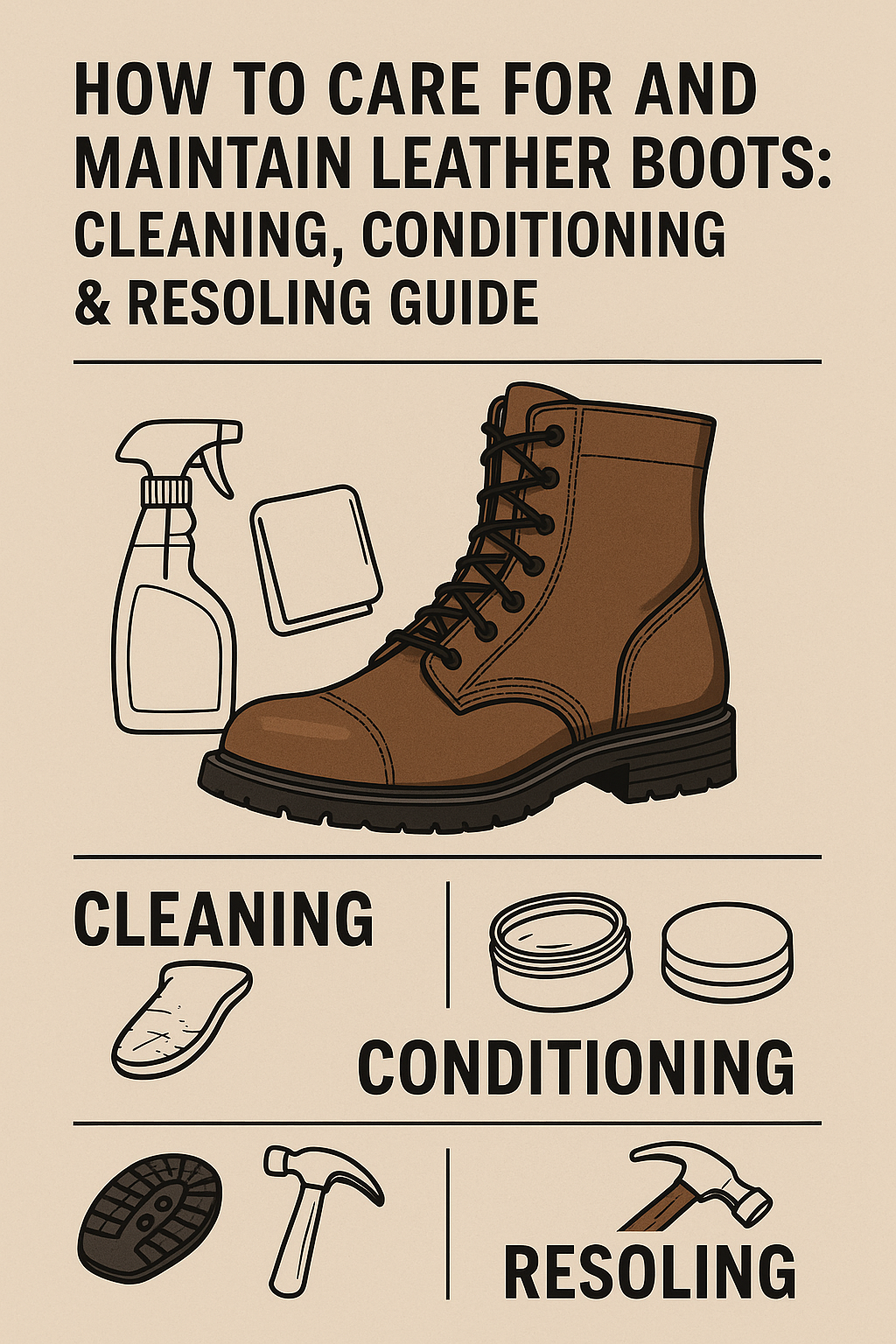
How to Care for and Maintain Leather Boots: Cleaning, Conditioning & Resoling Guide
Published on May 05, 2025
How to Care for and Maintain Leather Boots: Cleaning, Conditioning & Resoling Guide
Whether you’re a reenactor preserving historical authenticity, a WW1 military enthusiast, or someone who just appreciates rugged, reliable leather boots, one thing is certain: proper boot care is essential. Leather boots, especially vintage or service-worn pairs, are an investment. To ensure they last for years—both in appearance and function—you’ll need to follow a consistent cleaning, conditioning, and maintenance routine.
In this article, we’ll cover:
- How to clean leather boots with household items
- Tips for conditioning and preserving leather
- When and where to get your boots resoled
- Basic leather boot repair techniques
- Long-term storage and preservation
Let’s get started with the first step—cleaning.
1. How to Clean Leather Boots with Household Items
You don’t need expensive products to clean your leather boots. Many effective solutions can be found right in your kitchen.
Step-by-Step Cleaning Process
What you’ll need:
- A soft cloth or an old T-shirt
- Soft-bristled brush (toothbrush works too)
- White vinegar
- Olive oil or coconut oil
- Mild dish soap
- Warm water
Instructions:
- Remove Dirt & Debris
- Use the brush to remove dirt and dust from seams, soles, and crevices. Don’t forget the tongue and laces.
- Create a Gentle Cleaner
- Mix one part vinegar with two parts water. Add a small drop of dish soap for grease removal.
- Wipe Down with a Cloth
- Dampen the cloth in your cleaning mix and gently scrub the boot in small circles. Don’t saturate the leather—use just enough moisture to lift the grime.
- Dry Thoroughly
- Let the boots dry naturally in a well-ventilated area. Avoid direct sunlight or heaters, which can cause leather to crack.
- Condition Immediately (see next section)
2. How to Clean and Condition Leather Boots
Cleaning leather is just half the battle. Without proper conditioning, leather can dry out and lose its flexibility.
DIY Leather Conditioner Using Household Oils
If you don’t have a commercial conditioner, try this:
- Mix equal parts of olive oil and vinegar. The oil hydrates the leather, and the vinegar prevents mildew.
Use a soft cloth to rub the mixture into the leather. Let it soak in for 10–15 minutes, then buff with a clean cloth to restore shine and finish.
Tips for Conditioning Leather Boots:
- Apply conditioner after every thorough cleaning.
- Avoid over-conditioning—it can weaken the leather over time.
- Never use vegetable oils like corn or sunflower oil. These can go rancid.
3. When & Where to Get Boots Resoled
Even the best-kept boots will eventually need new soles. This is especially true for military-style boots, which endure rugged terrain and heavy wear.
Signs Your Boots Need Resoling:
- Worn-out tread or heel drag
- The noticeable separation between the sole and upper
- Reduced traction or foot fatigue
Where to Get Boots Resolved:
Option 1: Local Cobbler
Support your local craftsman. Many cobblers specialize in heritage and military boots and can replicate the original look.
Option 2: Mail-In Boot Repair Services
Websites like Paddelaters.com often offer resoling or partner with trusted repair shops for military-style boots. Look for those experienced with vintage or historically accurate restoration.
Option 3: DIY Boot Resoling (Advanced Users)
If you have the right tools and a bit of experience, you can resolve boots at home. Just be aware—doing it wrong can damage the structure of your boot permanently.
4. Leather Boot Repair Tips
Aside from sole replacement, other parts of the boot may need occasional repairs.
Common Boot Repairs:
- Stitching: Use heavy-duty thread and a leather needle. Hand-stitching is time-consuming but worth it.
- Scuffs and Scratches: Minor scuffs can be treated with colored shoe polish or wax.
- Waterproofing: Use beeswax or a silicone-based spray to restore water resistance.
For historical boots, aim for products that won’t alter the leather’s original appearance.
5. Long-Term Leather Boot Storage
If you rotate your boots or store them between reenactment seasons, proper storage is key to preventing mold, mildew, and cracking.
Storage Tips:
- Keep Boots in a Dry, Cool Space
- Humidity is the enemy of leather. Avoid basements or attics unless dehumidified.
- Use Boot Trees
- These help maintain shape and prevent sagging.
- Store in a Cloth Bag
- Never in plastic. Leather needs to breathe.
- Avoid Direct Light
- UV rays can discolor and weaken the leather.
Conclusion: Keep Your Leather Boots Ready for Duty
Caring for leather boots—especially historical or military pairs—is more than a chore. It’s a ritual that ensures your gear stays functional, comfortable, and true to its original spirit. Whether you’re marching in a reenactment, preserving a family heirloom, or simply walking with purpose, proper care extends the life and beauty of your boots.
